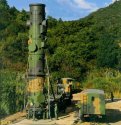another very interesting link.
Inside story about China's first H-bomb development
On June 17, 1967, a small fighter plane released a parachute above the skies over Xinjiang, in northwestern China. When the parachute was 3000 meters above the ground, it exploded. With a huge "bang", a huge mushroom cloud arose.
China had the H-bomb! The news shocked the world because it took the US seven years and three months, and the former Soviet Union, four years and three months, to develop the hydrogen (H) bomb after the atom (A) bomb. However, China, which was then very backward in its comprehensive strength, only spent two years and eight months to develop the H-bomb after the A-bomb.
Forty years later, according to a China Youth Daily report, some experts recalled their stories and told us some stories from that time.
A breakthrough in H-bomb theory by young research team
There were 100,00 people working in the nuclear industry at that time, and 68% of them were below twenty-five years of age, while 25.5% of them were between twenty-six and thirty-five.
In May 1964, when former national leader, Mao Zedong, heard the third five-year plan, he pointed out that "China should have the A-bomb and soon it should have the H-bomb too."
Researchers, then, only knew the basic concepts of the H-bomb. As for how to manufacture the H-bomb,-what was at its core- none of them had any idea. Li Yanxiang, director of the office of the former Ministry of Nuclear Industry, recalled that for a period of time, the young research team felt they had run out of ideas. Complicated calculations became one of the main reasons for research being slow. In the 1960s, China only had one computer with a speed of 10 thousand times of calculations per second. In addition, it was used for testing the atom bomb most of the time. Research fellow, Yu Min, who was dubbed the "number one home-grown expert," and his colleagues, often used a calculator to count day and night.
One day they obtained an important reference number from foreign sources, but they questioned how this number came about. Therefore, they needed to test the validity of this number. Yu Min pondered this issue for days.
One night he woke up from a nightmare and he held his wife's hand shouting, "I got it, I got it, it's clear to me, it's clear to me!"
Li Yanxiang said that by 1965, research of the H-bomb had made great progress. As a result, dozens of science and research personnel traveled to Shanghai from Beijing. At that time, everybody had to take their own backpacks because there were not enough quilts available for them in Shanghai.
The computer had to print every result out on paper and people had to read the paper that sometimes was held in large linen bags. They spent a lot of time reading these data and were careful with every sheet of paper so as to preserve the accuracy of the data.
Beginning in September 1965, after 100 days of calculation, there was a breakthrough. After this, research was on the fast track. "Deng Jiaxian, who was in Beijing then, immediately came to Shanghai upon hearing the news, and invited all of us to lunch. Although it was just a bowl of noodles, we were all very happy," Li Yanxiang reminisced.
Statistics showed that Deng Jiaxian was just 34 years old at the time; Zhu Guangya, also 34; Zhou Guangzhao, 32; and Ou Yangyu, 31. At that time, 90% of the 100,000 nuclear energy researchers were between the ages of 25 and 35 years.
The battle in the 'Golden Sand' area
While researchers conducted experiments with A-bombs and H-bombs in the 'Golden Sand' grassland in Qinghai province, in northwest China, the 221st site was being built. It became China's first nuclear factory.
Seventy- year- old Wang Jingheng was the director of the factory. He graduated from a famous university in 1960 and then he was sent to the ��frontline'. In January 1961, Wang Jingheng and his four classmates traveled from Beijing to Lanzhou by train. However, a train from Lanzhou to Xining did not exist, so they had to sit in a cargo train. The cold wind made their hands and feet feel dumb. They only shared one cotton overcoat during the ten hour trip. From Xining to the site, traffic not exist either. As the Chinese New Year was approaching, they all had to stay in Xining for a week, in order to wait for a cargo truck that sent daily necessities to the site. They sat on pots which contained pickled dishes. They survived the cold wind and finally arrived at the site by truck.
At that time, there were hundreds of thousands of people in the site, living in caves and eating barley and millet flour with a little oil. The only dish they could eat was Chinese cabbage soup. If they felt hungry, they could gather wild vegetables. Wang Jingheng said although life was hard, people's spirit were very good, hopeful, and positive.
At that time, they all had to keep their discovery a secret. The place was also a mining area. In addition to the lack of oxygen, the ultraviolet rays from the sun were very strong. Many people's skin became very dark. Nevertheless, they could not reveal to their families the true nature of their work. When some people went home, their children asked: "Daddy, while you work in the mining area, do you dig up coal everyday?" Father could only say "yes."
Li Yanxiang said he thinks it is still of great significance to recall the successful launching of the H-bomb forty years ago. Particularly in the high-tech field, leaders and researchers should be as confident as those who worked forty years ago.
By People's Daily Online



